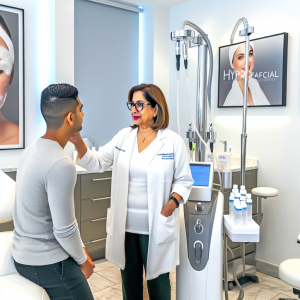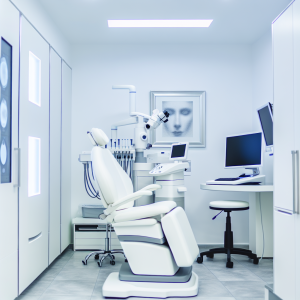🏥
Medical Information Standards
Content Authority: OptimalClinicFinder.com is a comprehensive medical directory platform connecting patients with qualified Acne Scar Treatment providers. Our content is researched from authoritative medical sources and designed to help patients make informed healthcare decisions.
How Fractional CO2 Laser Technology Works: Clinical Mechanisms
Fractional CO2 laser technology operates on the principle of selective photothermolysis, utilizing a 10,600-nanometer wavelength that targets water molecules in skin tissue. The laser creates thousands of microscopic treatment zones called microthermal zones (MTZs), each measuring 100-200 micrometers in diameter. This fractional approach treats only a percentage of the skin surface while leaving surrounding tissue intact, promoting rapid healing and reducing downtime compared to traditional ablative resurfacing.
The controlled thermal injury created by the CO2 laser stimulates immediate collagen contraction and initiates a cascade of wound healing responses. Fibroblasts proliferate and produce new collagen, elastin, and glycosaminoglycans over the following months. This neocollagenesis process continues for up to 12 months post-treatment, providing progressive improvement in skin texture, tone, and structural integrity.
💡
Did You Know?
Clinical studies show that Acne Scar Treatment patients achieve excellent results when combined with professional-grade aftercare products.
Clinical Applications and Treatment Indications
Fractional CO2 laser therapy demonstrates exceptional efficacy for multiple dermatological conditions. Primary indications include moderate to severe acne scarring, particularly ice pick, boxcar, and rolling scars that respond poorly to less aggressive treatments. The technology excels at treating photodamage including solar lentigines, actinic keratoses, and diffuse sun damage. Deep rhytides, particularly perioral and periorbital wrinkles, show significant improvement with fractional CO2 resurfacing.
Advanced applications include treatment of surgical scars, striae distensae, and benign epidermal lesions. The laser’s precision allows for targeted treatment of specific lesions while preserving surrounding healthy tissue. Recent clinical studies have demonstrated efficacy for treating melasma in darker skin types when combined with appropriate pre- and post-treatment protocols.
Treatment Protocols and Clinical Procedures
Successful fractional CO2 laser treatment requires meticulous planning and execution. Pre-treatment preparation begins 4-6 weeks before the procedure with tretinoin conditioning to optimize cellular turnover and healing response. Patients with Fitzpatrick skin types III-VI require additional preparation including hydroquinone or kojic acid to minimize post-inflammatory hyperpigmentation risk.
The treatment procedure involves comprehensive skin cleansing, topical anesthesia application, and eye protection protocols. Laser parameters are customized based on indication, skin type, and desired outcomes. Typical settings range from 5-20% coverage with energy levels of 15-60 millijoules per microbeam. Multiple passes may be performed for severe scarring, with careful attention to tissue response and thermal accumulation.
💡
Quick Tip
Acne Scar Treatment works best when combined with healthy lifestyle choices for optimal results.
Recovery Timeline and Expected Outcomes
The fractional CO2 laser recovery process follows a predictable timeline with specific milestones. Immediate post-treatment effects include erythema, edema, and pinpoint bleeding at treatment sites. Days 1-3 involve continued swelling and onset of desquamation. The acute inflammatory phase typically peaks at 48-72 hours, requiring diligent wound care and sun protection.
Epithelialization occurs within 5-7 days, with most patients able to return to normal activities with makeup coverage. Erythema gradually fades over 2-6 weeks, depending on treatment depth and individual healing response. Collagen remodeling continues for 6-12 months, with optimal results typically visible at 3-6 months post-treatment. Studies demonstrate 50-80% improvement in acne scarring and 60-90% improvement in photodamage markers.
Safety Considerations and Risk Management
While fractional CO2 laser treatment is generally safe when performed by qualified providers, potential complications require careful consideration. Common side effects include prolonged erythema, post-inflammatory hyperpigmentation, and delayed healing. These occur in 5-15% of patients and typically resolve with appropriate management.
Serious complications are rare but can include infection, scarring, and permanent pigmentary changes. Risk factors include active skin infection, recent isotretinoin use, history of keloid formation, and unrealistic patient expectations. Proper patient selection, sterile technique, and adherence to established protocols minimize complication rates to less than 2% in experienced hands.
Cost Analysis and Investment Considerations
Fractional CO2 laser treatment represents a significant investment in skin health and appearance. Treatment costs vary based on geographic location, provider experience, facility overhead, and treatment complexity. Full-face treatments typically range from $2,000-$5,000, while targeted treatments for specific areas may cost $800-$2,500.
⚠️
Safety First
Always consult a qualified medical professional before starting Acne Scar Treatment. Results vary by individual.
✓
Why Choose Acne Scar Treatment?
●
Clinically proven
●
FDA approved
●
Minimal downtime
●
Long-lasting
Most patients require 1-3 treatments spaced 3-6 months apart to achieve optimal results. When compared to the cumulative cost of less effective treatments or the long-term benefits of improved skin quality, fractional CO2 laser therapy often provides superior value. Financing options and package pricing are commonly available to make treatment more accessible.
CO2 Laser Near Me: Provider Selection Criteria
Selecting an experienced provider for CO2 laser treatment is crucial for optimal outcomes and safety. Board certification in dermatology or plastic surgery provides the foundational medical knowledge required for safe laser operation. Additional fellowship training in dermatopathology or cosmetic surgery enhances diagnostic and technical skills.
Evaluate potential providers based on their experience with fractional CO2 laser systems, patient before-and-after galleries, and complication management protocols. Facilities should maintain proper laser safety certification, emergency protocols, and sterile procedure capabilities. The consultation process should include detailed treatment planning, realistic expectation setting, and comprehensive informed consent discussion.
Technology Advances and Future Developments
Current fractional CO2 laser technology continues to evolve with improved precision, safety features, and treatment protocols. Newer systems incorporate advanced cooling mechanisms, variable pulse durations, and computer-controlled pattern generation for enhanced consistency and outcomes. Integration with other technologies such as radiofrequency and ultrasound creates combination treatments with synergistic effects.
Future developments focus on minimizing downtime while maintaining efficacy, expanding treatment indications, and improving outcomes for darker skin types. Artificial intelligence integration may enable personalized treatment parameter selection based on individual skin characteristics and healing patterns. These advances promise to make fractional CO2 laser therapy more accessible and effective for diverse patient populations.
📚 Medical Authorities & Professional Standards
All Acne Scar Treatment procedures should be performed by licensed medical professionals following established clinical guidelines and safety protocols.
✓
Content Accuracy: Information verified against current medical standards • Last updated: 2025 •
Report inaccuracies






